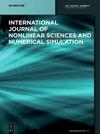On the penetration efficiency of ceramic fragments through steel targets
IF 1.5
4区 工程技术
Q2 ENGINEERING, MULTIDISCIPLINARY
International Journal of Nonlinear Sciences and Numerical Simulation
Pub Date : 2022-10-11
DOI:10.1515/ijnsns-2021-0430
引用次数: 0
Abstract
Abstract The penetration efficiency of novel ceramic fragments should be investigated, and their weapon damage effectiveness must be evaluated. In this study, the efficiency of ceramic fragments in penetrating steel targets were analyzed through ballistic impact tests and numerical simulations. The penetration patterns of these ceramic fragments through steel targets indicate significant perforation. It was deduced that the thicker the steel target, the greater the ability of ZrO2 ceramic fragments to penetrate. Results indicate that the thicker the steel target, the greater the ability of ZrO2 ceramic fragments to expand their perforation, while that of Al2O3 ceramic fragments is reduced as the thickness of the steel target is increased. In addition, the number of projectiles triggered by the perforation of the two ceramic fragments behind the targets decreases as the thickness of the steel target increases. Thus, the higher the impact velocity, the larger the perforation diameter of the ceramic fragments, and the larger the number of projectiles behind the target. Under the same impact velocity, the penetration ability of a ZrO2 ceramic fragment on steel targets was better than that of an Al2O3 ceramic fragment, and the number of projectiles behind the target was greater.陶瓷碎片对钢靶的穿透效率研究
摘要研究新型陶瓷破片的侵彻效率,评估其武器毁伤效能。通过弹道冲击试验和数值模拟分析了陶瓷破片侵彻钢靶的效率。这些陶瓷碎片穿过钢靶的穿透模式表明有明显的穿孔。结果表明,钢靶越厚,ZrO2陶瓷破片的穿透能力越强。结果表明:随着钢靶厚度的增加,ZrO2陶瓷片的扩孔能力越强,而Al2O3陶瓷片的扩孔能力随钢靶厚度的增加而降低。此外,随着钢靶厚度的增加,靶后两块陶瓷破片穿孔触发的弹丸数也随之减少。因此,冲击速度越高,陶瓷破片的穿孔直径越大,靶后的弹丸数也越多。在相同的冲击速度下,ZrO2陶瓷破片对钢靶的侵彻能力优于Al2O3陶瓷破片,且靶后弹丸数更多。
本文章由计算机程序翻译,如有差异,请以英文原文为准。
求助全文
约1分钟内获得全文
求助全文
来源期刊
CiteScore
2.80
自引率
6.70%
发文量
117
审稿时长
13.7 months
期刊介绍:
The International Journal of Nonlinear Sciences and Numerical Simulation publishes original papers on all subjects relevant to nonlinear sciences and numerical simulation. The journal is directed at Researchers in Nonlinear Sciences, Engineers, and Computational Scientists, Economists, and others, who either study the nature of nonlinear problems or conduct numerical simulations of nonlinear problems.

 求助内容:
求助内容: 应助结果提醒方式:
应助结果提醒方式:


